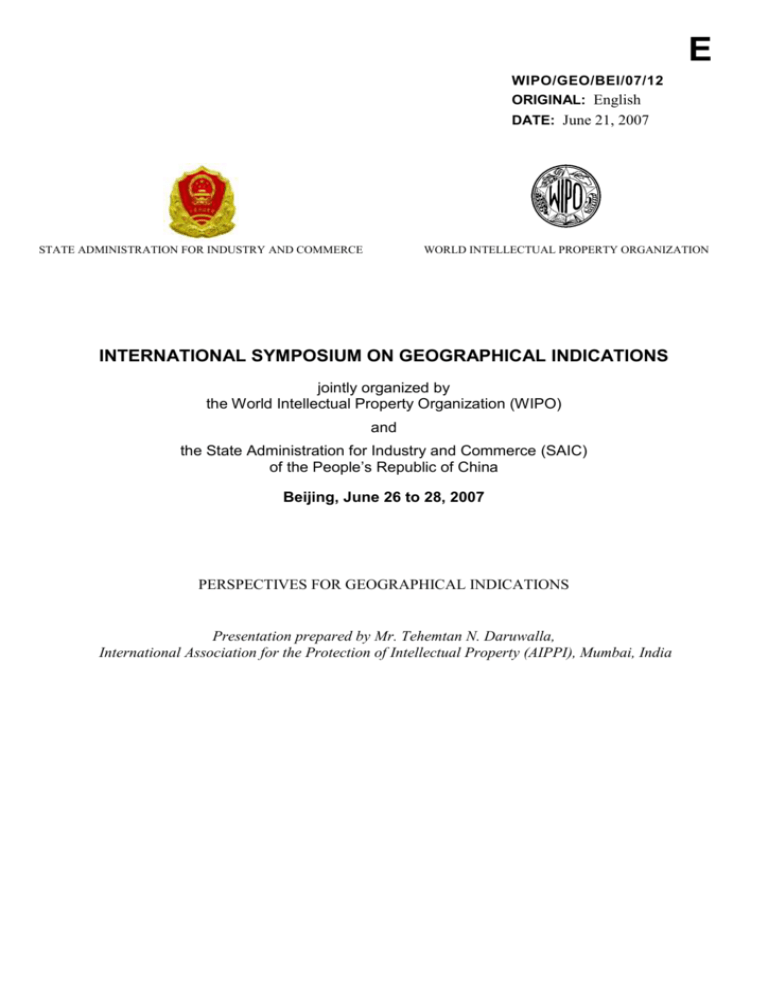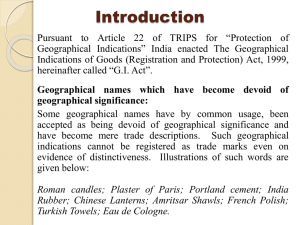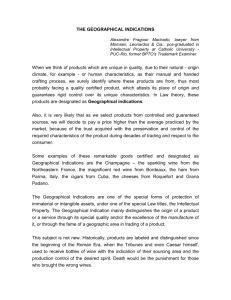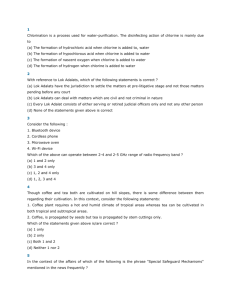Perspectives for Geographical Indications
advertisement

E WIPO/GEO/BEI/07/12 ORIGINAL: English DATE: June 21, 2007 STATE ADMINISTRATION FOR INDUSTRY AND COMMERCE WORLD INTELLECTUAL PROPERTY ORGANIZATION INTERNATIONAL SYMPOSIUM ON GEOGRAPHICAL INDICATIONS jointly organized by the World Intellectual Property Organization (WIPO) and the State Administration for Industry and Commerce (SAIC) of the People’s Republic of China Beijing, June 26 to 28, 2007 PERSPECTIVES FOR GEOGRAPHICAL INDICATIONS Presentation prepared by Mr. Tehemtan N. Daruwalla, International Association for the Protection of Intellectual Property (AIPPI), Mumbai, India WIPO/GEO/BEI/07/12 page 2 INTRODUCTION Registration issues Traders whilst adopting trade marks wish to refer therein to some geographical significations. If that geographical significance adds to the value of such a mark then all the better! Such reference to geographical significance can be direct or overt or covert. This creates problems. Question arises for consideration. Should exclusive rights be given to those who use geographical indications in relation to goods in which they deal, or should it be fenced off? Courts in United Kingdom, way back in 1894, took the view that even if an adjectival form of geographical name was adopted for registration as a trade mark ,then the mark must be refused registration. In that case [Sir Titus Salt, Bart Sons and Co’s. Application (11 RPC 517 Ch. D.)], the Application was to register the word “Eboline”. Eboli was the name of a town in Italy and had at that time just 11,000 inhabitants. Mr. Justice Chitty observed as follows: “For instance, it is plain that America, Asia, Africa, Europe, China, Japan, Argentina, Circassia, Anatolia, Rome, Paris, Florence, and Venice, fall within the prohibition; it is equally plain, I think, that the adjectival form of these places cannot be used, as American, Asiatic, African, European, Chinese, Japanese, Argentine, Circassian, Anatolian, Roman, Parisian, Florentine, or Venetian. This reasoning applies to “Eboline”; it is merely “Eboli” with the addition of the ordinary English suffix “ne”. The object of the Legislature was to prevent a trader from acquiring a monopoly in the name of a place, and from thereby suggesting that the goods had a local origin or a local connection which, in fact, they might not have.” In 1937, sections 9(3), 9(4), 9(5), 11, 33 & 34 of the Trade Marks Acts 1905 and 1919 of U. K. were taken up for consideration in the “LIVRON” case by the Court of Appeal (Boots Pure Drug Co. Ltd.’s T.M. (1937) 54 RPC 327. Here, “LIVRON” was already registered as an invented word for tonic medicines for human use in the name of Boots Pure Drug Co. Ltd. Subsequently, a French company applied for rectification of the Register on the ground that “Livron” is the name of a small town in France where they had a factory making medicines for human use. When Boots Pure Drug Co. Ltd. adopted the word “LIVRON”, they were not aware that there was a small town named Livron of hardly 4000 inhabitants in France. They adopted the word mark as a combination of “LIV” for “Liver” and “RON” from the word “IRON” – the intention being that it’s a tonic in which liver extract and iron were used. The Court of Appeal was not impressed and ruled that LIVRON was not an invented word – that it was a geographical name in its ordinary signification and confirmed the Order to expunge the mark from the Register of Trade Marks. Thus the Trade Marks Acts in U. K. and India have all along refused applications for registration of trade marks which have in its ordinary signification a geographical name. An important decision is the YORK trade mark case of House of Lords (1984) RPC 231 – a sample of the mark is reproduced: WIPO/GEO/BEI/07/12 page 3 It may be mentioned that the parent company of the Applicants had its principal place of business in York, Ontario. The Applicant was not connected with the City of York in England. The specification of goods was in relation to containers and trailers for freight. It was held that the geographical signification of the mark rendered it incapable in law of distinguishing the Applicant’s goods even though the mark was 100 per cent factually distinctive of the goods in question. Lord Justice Wilberforce quoted with approval the reasoning of Lord Simonds in the “Liverpool” case thus: “Just as a manufacturer is not entitled to a monopoly of a laudatory or descriptive epithet, so he is not to claim for his own a territory whether country, county or town which may be in the future, if it not now, the seat of manufacturer of goods to his own.” Passing off vis-à-vis geographical locations: There are cases in UK where parties have been restrained from using a GI or a geographical location as a trade mark or trade name in relation to the goods in which they deal in. Some of those cases are: “Spanish Champagne” case (1961) RPC 116 J. Bollinger & Ors. V. the Costa Brava Wine Co. Ltd. The “Spanish Champagne” case where plaintiffs who have champagne houses of France established that only the wine produced in the Champagne District of France by the Champagne House was known as “champagne”. The wine house had acquired a high reputation; and the use of Spanish Champagne would deceive by causing persons to believe that the wine so described was champagne. Mr. Justice Danckwerts at page 127 observed as follows: “It appears to me when the plaintiffs have shown that the description used by the defendants contains an untruthful statement that a wine which is not Champagne is Champagne, they have gone some way to establishing their case, and the Court might require to be satisfied that such an untrue statement was so clearly qualified as to be not likely to mislead.” The learned Judge quoted the words of Lord Justice Lindley in Slazenger & Sons V. Feltham & Co. (1889) 6 RPC, 531 @ 537: “One must exercise one’s common sense, and, if you are driven to the conclusion that what is intended to be done is to deceive if possible, I do not think it is stretching the imagination very much to credit the man with occasional success or possible success. Why should we be astute to say that he cannot succeed in doing that which he is straining every nerve to do?” “Sherry” case (1969) R.P.C. 1 Vine Products Ltd. & Ors v. Mackenzie & Co. Ltd & Ors. Sherry derived its name from the Jerez district of Spain, and for centuries wines of that area had been imported into England. However, for more than a century wines similar in character had been produced in England and in some foreign countries other than Spain, and sold in England either as “sherry type” wines or as “British Sherry”, “South African Sherry”, “Cyprus sherry” or “Australian Sherry”. Attempts were made by Spanish producers to claim exclusive right to word “Sherry”. Long acquiescence in sale of wines was established. The WIPO/GEO/BEI/07/12 page 4 word “Sherry” simpliciter meant, exclusively Spanish product. Injunction was granted only against use of “sherry” unqualified by other indication of origin. “Elderflower Champagne” case. (1993) F.S.R. 641, Ch. D. Taitinger S. A. & Ors. V. Allbev Ltd & Anr. Plaintiffs were producers of Champagne, and members of associations concerned with the regulation of champagne and French wines. As everyone knows, Champagne is a district in France, famous for its sparkling wines. Defendants produced a drink called “Elderflower Champagne”. This was sold in same kind of outlet as champagne with similar bottles and labels and wired corks similar to those used for champagnes. Plaintiffs sued in a representative capacity for passing off. It was held in appeal that: There was a misrepresentation that the defendant’s product was champagne being sold under the name “Elderflower”. It was claimed that there was a misrepresentation that the defendant’s product was champagne or in some way associated with it. That it was a reasonably foreseeable consequence of the misrepresentation that injury to the goodwill would result, and the misrepresentation was plainly calculated to injure the plaintiff’s goodwill. It was observed by Master of the Rolls, Sir Thomas Bingham that “the absence of substantial damage would not ordinarily justify the refusal of an injunction… since the E.C. Regulation 823/87 clearly treats as critical not the likelihood of damage but the risk of confusion. Passing Off issues: Geographical signification: Some of such actions decided in India are: In the Scotch Whisky Association v. Pravara Sahakar, AIR 1992 Bom. 294, an Indian case where defendants were selling Whiskey under the description “Blended with scotch” the word “with” was printed in small types. The label had the device of a Scottish drummer wearing a tartan kilt with a word mark Drum Beater. It also had the expression “Blended with six year old vatted Malt scotch”. The Bombay High Court held that defendants were passing off their whisky as Scotch whisky and interim injunction was granted. In another passing off action, filed by the Scotch Whisky Association vs. Mohan Meakin Ltd., the Bombay High Court expressly disagreed with the Budweiser decision of the U. K. Court (1984) FSR .413 and restrained the Defendants from using the word “SCOT” as a part of their trademark ROYAL SCOT in relation to whisky. In those days Scotch whisky was not sold in the open market in India. Geographical names which have become devoid of geographical significance: It is submitted that some geographical names have by common usage, been accepted as being devoid of geographical significance and have become mere trade descriptions. Such geographical indications cannot be registered as trade marks even on evidence of distinctiveness. Illustrations of such words are given below: WIPO/GEO/BEI/07/12 page 5 Roman candles; Plaster of Paris; Portland cement; India Rubber; Chinese Lanterns; Amritsar Shawls; French Polish; Turkish Towels; Eau de Cologne. These geographical indications have become generic names or indications and have lost its original meaning and have become common name of such goods and serves as a designation for or indication of the kind, nature, type or other property or characteristic of the goods. Such geographical indications or words, it is submitted would be prohibited from being registered as a Geographical Indication or as trade marks. The International Conventions relating to geographical indications or appellations of origin are as follows: The Paris Convention for the Protection of Industrial Property of 20th March, 1883; The Madrid Agreement for the Repression of False and Deceptive Indications of Source on goods of 14th April, 1891; The Lisbon Agreement for the protection of Appellations of Origin and their International Registration, 1958; and The Agreement on Trade-Related Aspects of Intellectual Property Rights (TRIPS) of 15th April 1994 GOTHENBURG CONGRESS, 2006 OF AIPPI In October, 2006, the AIPPI at the Gothenburg Congress carefully considered Question Q 191 namely, “Relationship between Trademarks and geographical indications” under the current national and international laws. 49 countries answered the Questionnaire and submitted detailed Group Reports. After detailed discussions and hearing views of members, the Working Committee in the Plenary Session passed the Resolution (Annex A). It studied the relationship between trade marks and geographical indications and took into consideration: i) the resolution of the AIPPI Executive Committee in Copenhagen in 1994 – Question 118 (Copenhagen Resolution) which dealt with “Trade and service marks and geographical indications” (Annex B); and ii) the Resolution of the 37th AIPPI Congress in Rio de Janeiro in 1998 - (Rio Resolution) on Question 62 “Appellations of origin, indications of source and geographical indications” (Annex C). The Gothenburg 2006 Resolution referred to the Rio Resolution and noted that geographical indications are protected under an increasing number of national laws and bilateral and multilateral treaties with divergent and some times contradictory results. Now isn’t this just the very thing on which this International Symposium should concentrate so that these divergent views and sometimes contradictory results could be avoided or at least smoothened? That’s what AIPPI stands for. Let there be a healthy consensus on such divergent views. WIPO/GEO/BEI/07/12 page 6 It adopts, as mentioned in the Rio Resolution, the definition of “geographical indication” contained in Article 22(1) of the TRIPS Agreement, that is to say: “Geographical indications are, indications which identify a good as originating in the territory of a state, or a region or locality in that territory, where a given quality, reputation or other characteristic of the good is essentially attributable to its geographical origin.” The entire text of Section 3 which covers Geographical Indications (Article 22 to Article 24) of TRIPS is marked (Annex D). This definition should satisfy most nations-though it does not refer to situations where such goods are manufactured goods and one of the activities of either the production or of processing or preparation of the goods concerned takes place in such territory, region or locality as the case may be. Furthermore, the definition proposed by AIPPI does not deal with geographical indications in relation to services. The definition of “geographical indication” should be finalized in the interest of harmonization. The next guiding principle to be considered for settling conflicts between trade marks and geographical indications should be the “first in time, first in right” rule (i.e., priority in use or registration). The aim always being with a view of avoiding practices which are likely to mislead the public or misappropriate the reputation of the protected geographical indication or trade mark. Up to this stage the Resolution supports the correct view that the interests of the public are paramount. But it goes further and emphasizes that in such guiding principle it should be taken into account the reputation of the geographical indication and of the trade mark, the length of time that the geographical indication and the trade mark have been used, the extent and bonafides of each such usage, the likelihood and degree of any confusion, and, if applicable, acquiescence. A vast majority of countries in their reports to the AIPPI have agreed to the guiding principle for settling conflicts between trade mark and geographical indications of “first in time, first in right ” rule (i.e., priority in use or registration) with factors to be taken into account as set out in the Gothenburg Resolution. On this aspect there should be an agreement. But the main question remains as to how the international legal framework for geographical indications should be developed in order to reach satisfactory solutions for all parties having an interest in the protection and use of geographical indications. Three issues continue to be debated. Some consensus must be arrived at: 1) Apart from enhanced level of protection given to wines and spirits in Article 23 of the TRIPs, should this level of protection not be given to all significant products which concern various nations? Article 24.1 of TRIPs Agreement provides that Members agree to enter into negotiations aimed at increasing the protection of individual geographical indications under Article 23 (which relates to wines and spirits). Article 24.1 does not clarify whether the negotiations should be of a bilateral or multilateral nature even though Article 24.1 of TRIPs refers to “individual geographical indications” and to those indications covered in Article 23 which is for wines and spirits. WIPO/GEO/BEI/07/12 page 7 Some Member countries consider this as permitting negotiations so as to enhance the protection of geographical indications to goods other than wines and spirits. For example, Turkey and the Czech Republic demand an additional protection for foodstuffs and handicraft products. India insists on additional protection for their Basmati rice, Darjeeling Tea, Kancheepuram Sarees, Alphonso mangoes and the like. There are number of arguments for and against increased protection to be given to products other than wines and spirits. For example, certain Members plead and which in fact is true, that additional protection for geographical indications for products other than wines and spirits adds value for exports because it increases the chances of market access for such goods. Furthermore, by relying on the provisions of article 23 (1) there is no need to show in respect of a wrongful use of a geographical indication that the public has been misled or that there has been an act of unfair competition. Another argument is that by denying Article 23 kind of protection to geographical indications for goods other than wines and spirits, there is a risk that they would become generic, unlike wines and spirits. Those who argue against further protection say that there is no evidence to show that Article 22 has failed to protect geographical indications for products other than wines and spirits. By extending the scope of Article 23.1 additional obligations under TRIPS Agreement would be created. The legal and administrative costs necessary to implement new laws and administrative mechanism which will be associated with extending the scope of Article 23.1 would be very high. 2) Should a multilateral register for geographical indications which is legally binding on all parties be created? The AIPPI in paragraph 5 of its Gothenburg Resolution on Question Q191 suggests a voluntary multilateral system of notification of geographical indications and databases. However, it does not go into the question of whether there should be a multilateral system for all nations and the nitty gritty of such a System. Paragraph 5 of the Resolution reads as follows: “A voluntary system of notification of geographical indications should be established for information purposes. This should be recorded on a database which is searchable on line, free of charge and accessible to all members of the public. No inference should be drawn by participation or non-participation in the system.” 3) Should the multilateral register be restricted to only wines and spirits? The text of the said paragraph 5 of the Gothenburg Resolution does not restrict geographical indications being notified for wines and spirits only. It may be noted that Article 23(4) of the TRIPs Agreement which provides for the multilateral system of notification of geographical indications states that in order to facilitate the protection of geographical indications for wines, negotiations shall be undertaken in the Council for TRIPS concerning the establishment of a multilateral system of notification and registration of geographical indications for wines eligible for protection in those Members participating in the system. The AIPPI has addressed these important issues in a totally transparent manner and irrespective of whether national and/or multilateral registration systems are put in place on a mandatory or voluntary basis. I have always believed and still do that virtue knows no geography. Some of the instances which have been given by me, and some of those cases in which predators have misappropriated the Geographical Indications of my country to which I have deliberately not referred to, have not shaken this belief. Such predators who have never even heard of Edmund Rostand, how can you ever expect them to echo the feelings of Cyrano de Bergerac when he said: WIPO/GEO/BEI/07/12 page 8 “My soul, be satisfied with flowers, with fruits, with weeds even, But gather them in the one garden you may call your own.” These people didn’t! [Annex A follows] WIPO/GEO/BEI/07/12 page 9 ANNEX A WIPO/GEO/BEI/07/12 page 10 ANNEX A WIPO/GEO/BEI/07/12 page 11 ANNEX B WIPO/GEO/BEI/07/12 page 12 ANNEX B WIPO/GEO/BEI/07/12 page 13 ANNEX B WIPO/GEO/BEI/07/12 page 14 ANNEX B WIPO/GEO/BEI/07/12 page 15 ANNEX B WIPO/GEO/BEI/07/12 page 16 ANNEX C WIPO/GEO/BEI/07/12 page 17 ANNEX C WIPO/GEO/BEI/07/12 page 18 ANNEX C WIPO/GEO/BEI/07/12 page 19 ANNEX C WIPO/GEO/BEI/07/12 page 20 ANNEX D TRADE RELATED ASPECTS OF INTELLECTUAL PROPERTY RIGHTS (TRIPs) SECTION 3: Article 22 Protection of Geographical Indications 1. Geographical indications are, for the purposes of this Agreement, indications which identify a good as originating in the territory of a Member, or a region or locality in that territory, where a given quality, reputation or other characteristic of the good is essentially attributable to its geographical origin. 2. In respect of geographical indications, Members shall provide the legal means for interested parties to prevent: (a) the use of any means in the designation or presentation of a good that indicates or suggests that the good in question originates in a geographical area other than the true place of origin in a manner which misleads the public as to the geographical origin of the good; (b) any use which constitutes an act of unfair competition within the meaning of Article 10bis of the Paris Convention (1967). 3. A Member shall, ex officio if its legislation so permits or at the request of an interested party, refuse or invalidate the registration of a trademark which contains or consists of a geographical indication with respect to goods not originating in the territory indicated, if use of the indication in the trademark for such goods in that Member is of such a nature as to mislead the public as to the true place of origin. 4. The protection under paragraphs 1, 2 and 3 shall be applicable against a geographical indication which, although literally true as to the territory, region or locality in which the goods originate, falsely represents to the public that the goods originate in another territory. Article 23 Additional Protection for Geographical Indications for Wines and Spirits 1. Each Member shall provide the legal means for interested parties to prevent use of a geographical indication identifying wines for wines not originating in the place indicated by the geographical indication in question or identifying spirits for spirits not originating in the place indicated by the geographical indication in question, even where the true WIPO/GEO/BEI/07/12 page 21 ANNEX D origin of the goods is indicated or the geographical indication is used in translation or accompanied by expressions such as “kind”, “type”, “style”, “imitation” or the like. 2. The registration of a trademark for wines which contains or consists of a geographical indication identifying wines or for spirits which contains or consists of a geographical indication identifying spirits shall be refused or invalidated, ex officio if a Member's legislation so permits or at the request of an interested party, with respect to such wines or spirits not having this origin. 3. In the case of homonymous geographical indications for wines, protection shall be accorded to each indication, subject to the provisions of paragraph 4 of Article 22. Each Member shall determine the practical conditions under which the homonymous indications in question will be differentiated from each other, taking into account the need to ensure equitable treatment of the producers concerned and that consumers are not misled. 4. In order to facilitate the protection of geographical indications for wines, negotiations shall be undertaken in the Council for TRIPS concerning the establishment of a multilateral system of notification and registration of geographical indications for wines eligible for protection in those Members participating in the system. Article 24 International Negotiations; Exceptions 1. Members agree to enter into negotiations aimed at increasing the protection of individual geographical indications under Article 23. The provisions of paragraphs 4 through 8 below shall not be used by a Member to refuse to conduct negotiations or to conclude bilateral or multilateral agreements. In the context of such negotiations, Members shall be willing to consider the continued applicability of these provisions to individual geographical indications whose use was the subject of such negotiations. 2. The Council for TRIPS shall keep under review the application of the provisions of this Section; the first such review shall take place within two years of the entry into force of the WTO Agreement. Any matter affecting the compliance with the obligations under these provisions may be drawn to the attention of the Council, which, at the request of a Member, shall consult with any Member or Members in respect of such matter in respect of which it has not been possible to find a satisfactory solution through bilateral or plurilateral consultations between the Members concerned. The Council shall take such action as may be agreed to facilitate the operation and further the objectives of this Section. 3. In implementing this Section, a Member shall not diminish the protection of geographical indications that existed in that Member immediately prior to the date of entry into force of the WTO Agreement. WIPO/GEO/BEI/07/12 page 22 ANNEX D 4. Nothing in this Section shall require a Member to prevent continued and similar use of a particular geographical indication of another Member identifying wines or spirits in connection with goods or services by any of its nationals or domiciliaries who have used that geographical indication in a continuous manner with regard to the same or related goods or services in the territory of that Member either (a) for at least 10 years preceding 15 April 1994 or (b) in good faith preceding that date. 5. Where a trademark has been applied for or registered in good faith, or where rights to a trademark have been acquired through use in good faith either: (a) before the date of application of these provisions in that Member as defined in Part VI; or (b) before the geographical indication is protected in its country of origin; measures adopted to implement this Section shall not prejudice eligibility for or the validity of the registration of a trademark, or the right to use a trademark, on the basis that such a trademark is identical with, or similar to, a geographical indication. 6. Nothing in this Section shall require a Member to apply its provisions in respect of a geographical indication of any other Member with respect to goods or services for which the relevant indication is identical with the term customary in common language as the common name for such goods or services in the territory of that Member. Nothing in this Section shall require a Member to apply its provisions in respect of a geographical indication of any other Member with respect to products of the vine for which the relevant indication is identical with the customary name of a grape variety existing in the territory of that Member as of the date of entry into force of the WTO Agreement. 7. A Member may provide that any request made under this Section in connection with the use or registration of a trademark must be presented within five years after the adverse use of the protected indication has become generally known in that Member or after the date of registration of the trademark in that Member provided that the trademark has been published by that date, if such date is earlier than the date on which the adverse use became generally known in that Member, provided that the geographical indication is not used or registered in bad faith. 8. The provisions of this Section shall in no way prejudice the right of any person to use, in the course of trade, that person's name or the name of that person's predecessor in business, except where such name is used in such a manner as to mislead the public. 9. There shall be no obligation under this Agreement to protect geographical indications which are not or cease to be protected in their country of origin, or which have fallen into disuse in that country. [End of document and of Annexes]






